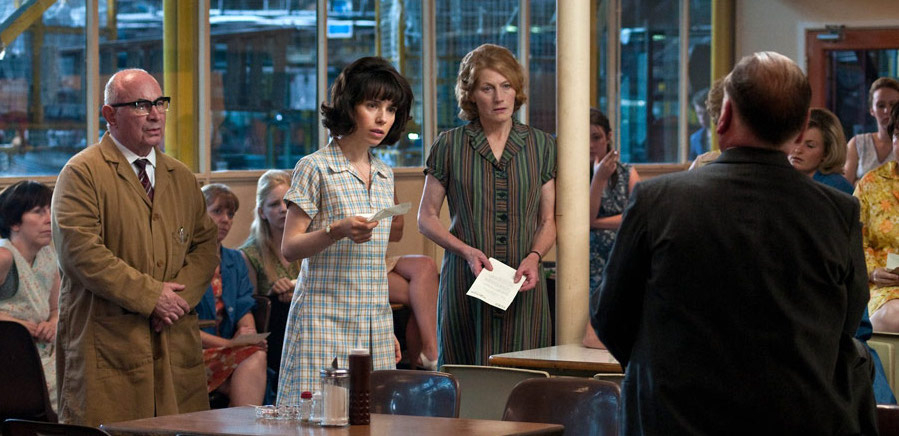Film Review: When Women Struck for Equal Pay

A 1968 strike by women auto workers in England is the focus of the lively British movie Made in Dagenham (2010). It’s just right for viewing (or re-viewing) during Women’s History Month. Photo: IMDB
In this occasional series, film buff and labor historian Toni Gilpin recommends movies that depict working people and their lives on the job.
If money talks, then it says one thing loud and clear: working women are still being shortchanged. On average in 2019, for every dollar American men were paid, women received only 80 cents. There are varying explanations, including that women tend to be clustered in lower-paying occupations.
But this gender pay gap used to be much wider, for one obvious reason: it was once perfectly legal to pay female employees less for the same work men did. This blatant discrimination was finally outlawed here in the U.S. by the Equal Pay Act of 1963.
Employers hadn’t suddenly become feminist converts: such laws came into existence, here and in other countries, thanks to earlier generations of women who demanded, and organized for, equal pay for equal work.
WOMEN ON STRIKE
One key moment in that struggle—a 1968 strike by women auto workers in England—is the focus of the lively British movie Made in Dagenham (2010). It’s just right for viewing (or re-viewing) during Women’s History Month. As we grapple with what it will take to completely close the pay gap, it’s worth reflecting on what it took to bring the cause of equal pay for women to the fore in the first place.
There are now just a few thousand employees at the massive Ford factory in Dagenham (located east of London) but back in 1968 its workforce topped 40,000; production employees were members of the British equivalent of the United Auto Workers. Only a few hundred were women, all employed in the department where automobile seat covers were fabricated.
In Made in Dagenham they are called “machinists,” and while in America that term implies skilled work, as the movie begins the women discover they’ve just been reclassified as unskilled labor, and furthermore will be paid less than men in that same category.
Rather than submit to such injustice, the women shut down their sewing machines and walk out.
Rita O’Grady (a fictional character, based on several actual workers) emerges as the film’s central figure. She has not previously been a union activist, but her chief steward Albert recognizes Rita’s potential and gently but persistently prods her to step up. The film thus provides a lesson in mentorship and the power that can be unleashed when rank and filers are encouraged into leadership roles.
There are not too many men like Albert, however, in Made in Dagenham. As the women press their demands, they must challenge contempt from their bosses (all men) along with condescension from top officials of their union (also all men).

SUPPORT LABOR NOTES
BECOME A MONTHLY DONOR
Give $10 a month or more and get our "Fight the Boss, Build the Union" T-shirt.
In an early scene, Rita and another striker are escorted by a senior union official into a meeting with Ford management. As the experienced negotiator, the official informs the women, he’ll do the talking—but the women discover to their dismay that this means conciliatory banter with the bosses.
Rita finally interrupts, pulling from her purse some car seat material that she has purloined from the factory, using it to demonstrate that what the women do involves considerable expertise and should be compensated accordingly.
This is an unusual moment, since working-class characters in movies rarely speak in detail and with passion about what their jobs entail. It also underscores that traditional “women’s work” was not easier or less skilled than the labor performed by men. Management got away with paying less for those jobs simply because women were doing them.
INITIAL EUPHORIA
All those who’ve been through strikes will recognize the initial liberating euphoria that gives way to mounting financial distress. Yet the women, standing fast, prevail upon the men in their plant, along with workers at Ford’s other British factory, to join the walkout, halting production in the country entirely.
The film also illustrates how strike demands, even those that seem at first to pertain just to a small group, can escalate to take on broader significance. What began as resistance to reclassification snowballed into a battle for pay equity that galvanized women’s rights activists around the world.
The Dagenham “machinists,” three weeks after they’d walked out, scored a victory on two fronts: Ford coughed up more money and the Labour government promised legislative support, which led to Britain’s Equal Pay Act of 1970.
For all its realism about working women’s experiences, Made in Dagenham is at bottom a feel-good Hollywood-style movie, with some unlikely (and fictitious) subplots. But so many films centered around the working class are infused with ugliness and despair; we could use more in the upbeat category. Especially when they’re based on real instances of workers taking on chiseling bosses, complacent union officials, and indifferent politicians—and winning.
The women in Made in Dagenham display plenty of moxie: just what’s needed to eliminate the pay gap for good and raise living standards for the entire working class.
Made in Dagenham is available for a few bucks on YouTube or Amazon Prime; use English subtitles if you find the working-class British dialects difficult to decipher.
Toni Gilpin is the author of the new book The Long Deep Grudge: A Story of Big Capital, Radical Labor, and Class War in the American Heartland Read a review in Labor Notes here.



